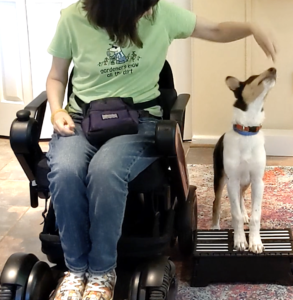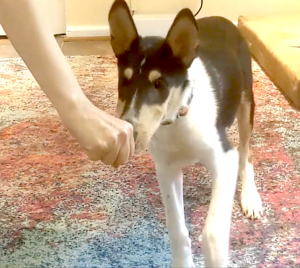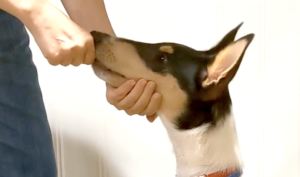When working with a young service dog in training, trainers focus on setting the groundwork for future public access. Service dogs in training need ongoing appropriate socialization in a variety of settings. Additionally, they need solid basic manners. They should respond quickly and reliably to cues to like sit, down, stay and leave it, as well as coming when called and paying attention when their handler says their name. In addition to these baseline skills, young service dogs can begin to learn some foundation skills that will be beneficial for future task training. Three behaviors in particular can be very helpful for service dog candidates.
Nose Touch to Hand
A simple nose touch to hand behavior has many uses in service dog training. The nose touch can be transferred to the handler’s leg and serve as an alert behavior. The behavior can also be transferred to a different target like a sticky, which can serve as the foundation for a push behavior. For instance, the owner can place a sticky on a cabinet door and teach the dog to push it closed. The dog can similarly be trained to push drawers, elevator buttons, accessible door buttons and even some kinds of light switches.
Chin Rest
Like a nose touch, a chin rest behavior can serve as an alert behavior, for instance as an anxiety alert. A chin rest can also be useful when training deep pressure therapy: The dog can be trained to rest their head on the person’s lap or foot. Chin rests are especially valuable when training retrieves, because they can be used to teach the dog to hold items steadily without chewing. In addition, incorporating a chin rest can be helpful in ensuring the dog delivers the item to the person’s hand rather than letting go too soon.
Front Paws on Platform
Teaching service dogs in training to place their front feet on a platform is useful for tasks that require precise positioning like assisting with balance and brace to support the owner getting up from a fall. Platforms are also helpful when training service dogs to assist with balance on stairs. Blocking, or having the service dog position themselves between the handler and the public, is a commonly requested service dog task for PTSD that can be taught using a platform as a target.

Many of the behaviors service dogs ultimately perform will require long, complex sequences of behaviors. These are best left for more mature service dog candidates. These three behaviors, however, are easy to teach and fun for dogs to learn. They are also a great way for handlers to get some early success with their service dog candidate, which will instill confidence in themselves, their dogs and their teamwork, while creating a strong foundation for the more challenging tasks that are yet to come.


